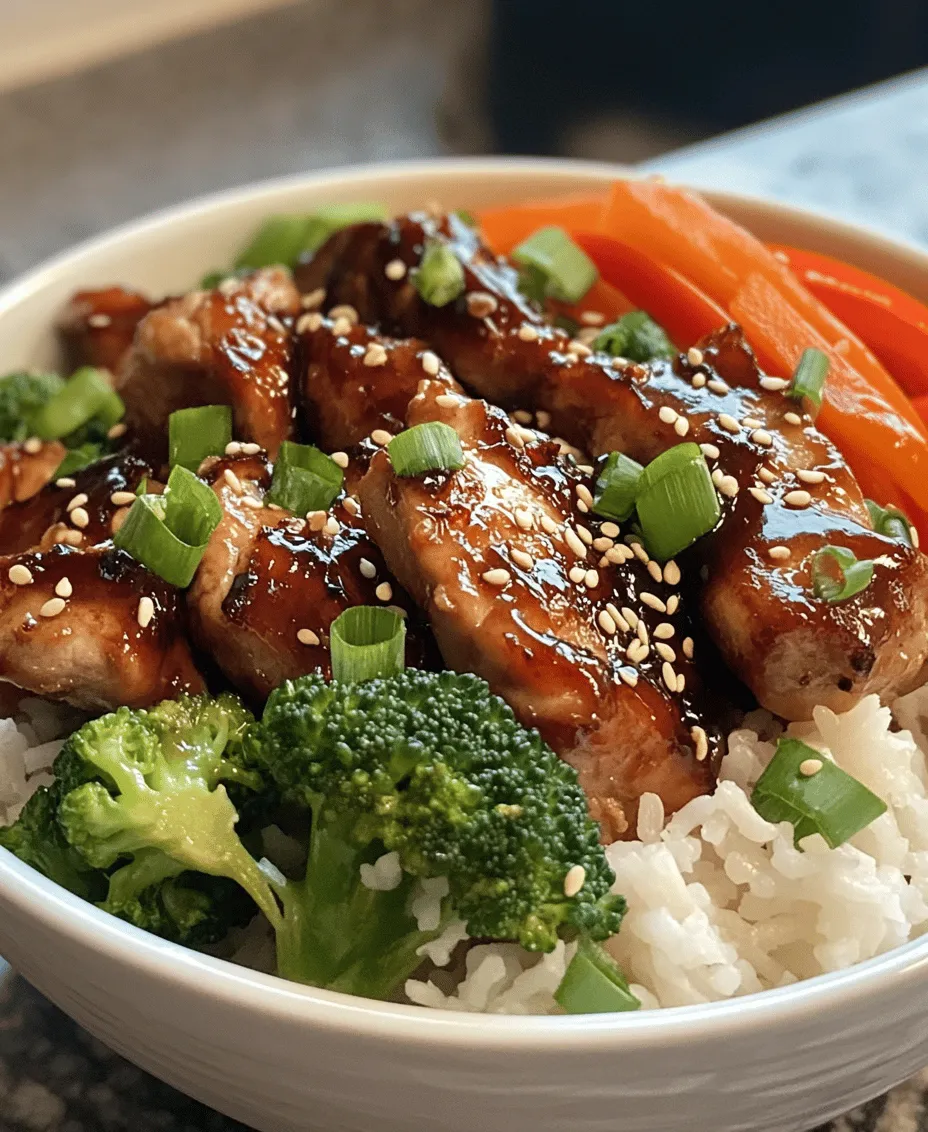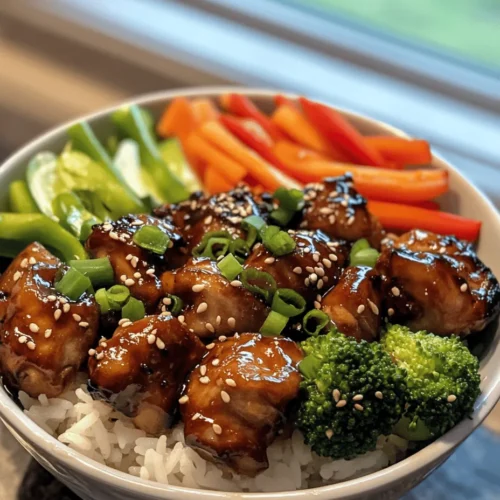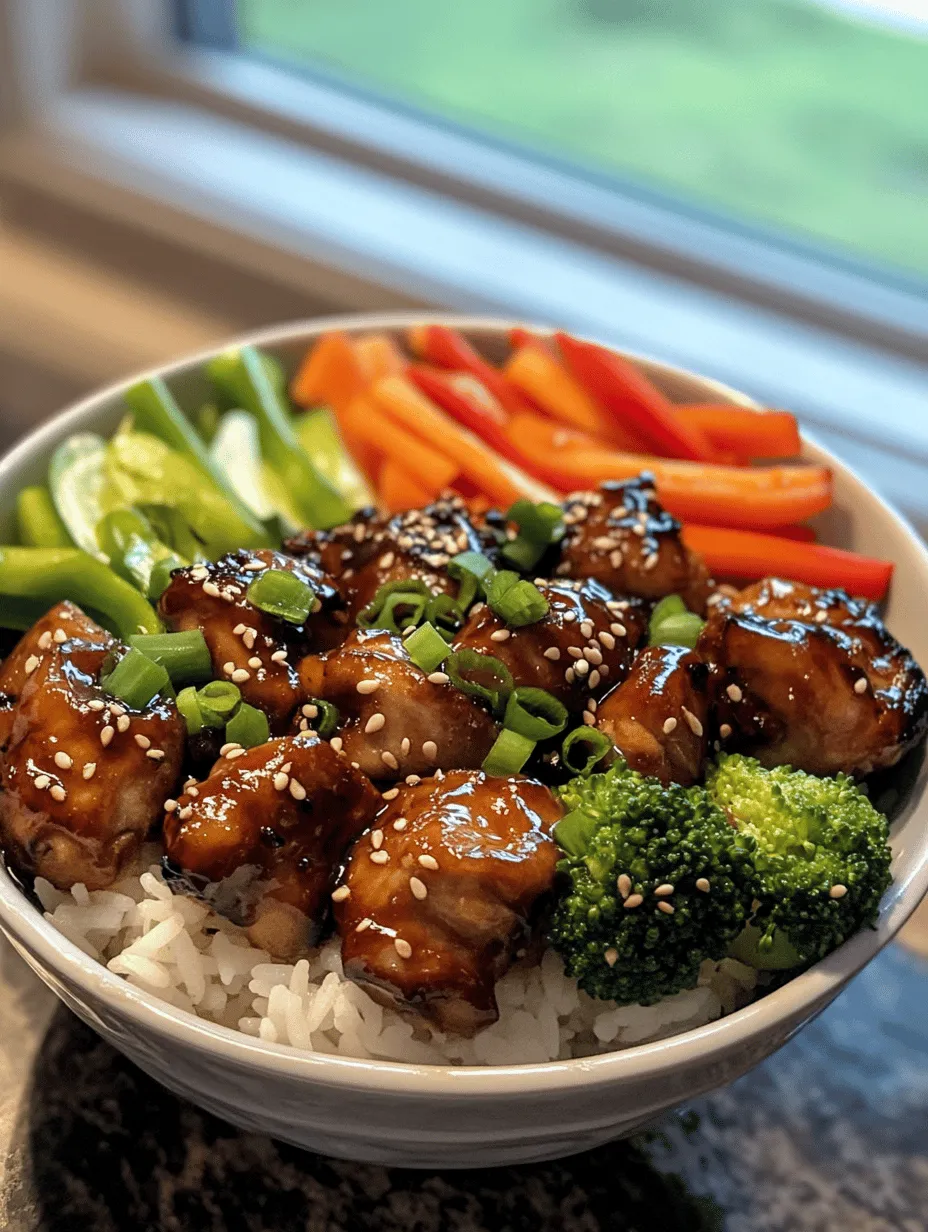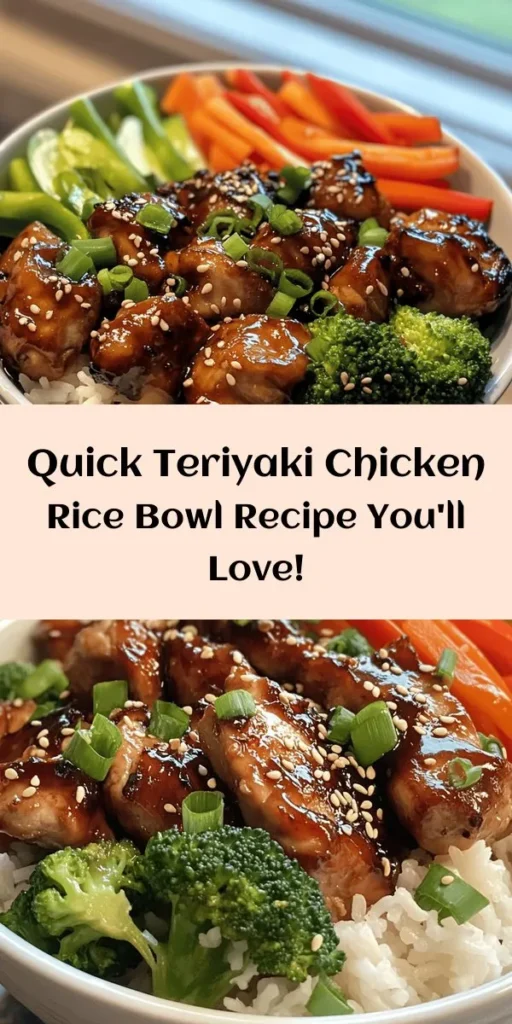In the vibrant world of cuisine, few dishes are as universally loved as the Teriyaki Chicken Rice Bowl. This delightful combination of tender chicken, colorful vegetables, and fluffy jasmine rice brings together a medley of flavors and textures that tantalize the taste buds. Whether you’re a busy parent seeking a quick meal or a culinary enthusiast looking to impress, this recipe offers a perfect blend of simplicity and taste. The Teriyaki Chicken Rice Bowl is not just a meal; it’s an experience that showcases the rich flavors of Japanese cuisine while being adaptable to suit various dietary preferences.
In this article, we will explore the origins of teriyaki, delve into the health benefits of the ingredients, and provide a step-by-step guide to creating this delicious dish at home.
Understanding Teriyaki: A Brief History
The term “teriyaki” comes from the Japanese words “teri,” which means glaze, and “yaki,” meaning to grill or broil. This cooking method dates back to the 17th century in Japan, where fish was often grilled with a glaze of soy sauce and sugar. Over time, the technique evolved to include a variety of proteins, particularly chicken, which has become a favorite in both Japan and the Western world.
Key ingredients that define teriyaki include soy sauce, mirin (a sweet rice wine), and sugar, which together create a rich, savory-sweet glaze that enhances the natural flavors of the chicken. The cultural significance of teriyaki in Japanese cuisine cannot be understated; it is a beloved comfort food that embodies the essence of Japanese cooking—simplicity, balance, and harmony of flavors.
As teriyaki gained popularity outside of Japan, it was adapted to local tastes, leading to variations that include additional ingredients like garlic, ginger, and even fruit juices. This adaptability has solidified teriyaki’s status as a global dish, with countless interpretations found in households and restaurants around the world.
Health Benefits of Ingredients in Teriyaki Chicken Rice Bowl
When it comes to the Teriyaki Chicken Rice Bowl, the nutritional composition of its ingredients contributes to its appeal as a wholesome meal.
Nutritional Value of Chicken Thighs
Chicken thighs are known for their rich flavor and juicy texture, making them a preferred choice for many cooks. Compared to chicken breasts, thighs are slightly higher in fat, which contributes to their moistness during cooking. This fat content also means that chicken thighs are a source of essential nutrients like iron and zinc, which are vital for maintaining good health. Additionally, chicken is an excellent source of high-quality protein, which helps in muscle repair and growth.
The Role of Vegetables in a Balanced Diet
Incorporating vegetables into the Teriyaki Chicken Rice Bowl not only adds color and texture but also boosts the nutritional value of the meal. Vegetables are packed with vitamins, minerals, and fiber, which are essential for overall health. Common choices for this dish include bell peppers, broccoli, and snap peas, each bringing their unique flavors and health benefits. For instance, broccoli is rich in vitamins C and K, while bell peppers add antioxidants and additional fiber.
Benefits of Jasmine Rice Over Other Rice Varieties
When it comes to the base of the Teriyaki Chicken Rice Bowl, jasmine rice stands out for its fragrant aroma and slightly sticky texture, making it ideal for holding onto the flavorful teriyaki sauce. Jasmine rice is a long-grain variety that is gluten-free and provides a good source of carbohydrates, which are essential for energy. Its slightly nutty flavor complements the savory elements of the dish, making each bite a delightful experience.
Understanding Soy Sauce and Its Low-Sodium Alternatives
Soy sauce is a cornerstone of teriyaki sauce and contributes to its distinctive umami flavor. However, traditional soy sauce can be high in sodium, which is something many people are mindful of in their diets. Thankfully, there are low-sodium soy sauce options available that retain the rich flavor while reducing salt intake. Alternatively, tamari sauce—often gluten-free—can be used for those with dietary restrictions.
Gathering Your Ingredients
Before diving into the cooking process, it’s essential to gather all your ingredients to ensure a smooth cooking experience. Here’s a quick overview of the essential components for creating the perfect Teriyaki Chicken Rice Bowl:
– Chicken Thighs: Boneless, skinless chicken thighs are recommended for their flavor and tenderness.
– Jasmine Rice: This aromatic rice variety will serve as the foundation of your bowl.
– Teriyaki Sauce: You can either purchase a pre-made sauce or prepare your own using soy sauce, mirin, sugar, and garlic.
– Vegetables: Choose a mix of your favorites; bell peppers, broccoli, carrots, and snap peas work beautifully.
– Garnishes: Optional ingredients like sesame seeds, chopped green onions, and pickled ginger can enhance both the flavor and presentation of the dish.
Substitutions for Dietary Restrictions
This recipe is highly adaptable, making it easy to accommodate dietary restrictions. For a gluten-free version, opt for tamari sauce instead of regular soy sauce. If you’re looking for a lower-carb option, consider substituting jasmine rice with cauliflower rice or quinoa, which will provide a similar texture while being lower in carbohydrates.
Where to Find Fresh Produce and Quality Sauces
The quality of your ingredients can make a significant difference in the final outcome of your Teriyaki Chicken Rice Bowl. Local farmers’ markets often provide fresh, seasonal vegetables at competitive prices. Additionally, consider visiting Asian grocery stores for authentic teriyaki sauce and other specialty ingredients. If you prefer making your own sauce, most of the required ingredients can be found in regular supermarkets or online.
Step-by-Step Guide to Making Teriyaki Chicken Rice Bowl
Now that you’ve gathered all your ingredients, it’s time to start cooking! Below is a detailed guide to help you prepare the Teriyaki Chicken Rice Bowl like a pro.
Preparing the Rice
1. Rinse the Jasmine Rice: Start by measuring out the desired amount of jasmine rice—typically, 1 cup serves about two people. Place the rice in a fine-mesh strainer and rinse it under cold running water. This step is crucial as it removes excess starch, which can lead to a gummy texture. Rinse until the water runs clear.
2. Cooking the Rice: After rinsing, transfer the rice to a medium saucepan. Add water according to the package instructions—generally, the ratio is 1 cup of rice to 1.5 cups of water. For added flavor, consider using chicken broth instead of water. Bring the mixture to a boil over medium-high heat.
3. Simmer and Steam: Once boiling, reduce the heat to low, cover the saucepan with a tight-fitting lid, and let it simmer for about 15 minutes. Avoid lifting the lid during this time, as it will release steam needed for cooking the rice properly. After 15 minutes, remove the saucepan from heat and let it sit covered for an additional 5-10 minutes to allow the rice to finish steaming.
Preparing the Chicken
1. Selecting and Slicing Chicken Thighs: Choose boneless, skinless chicken thighs for this recipe, as they are tender and flavorful. Trim any excess fat and slice the thighs into bite-sized pieces for even cooking and better absorption of the teriyaki sauce.
2. Marinating for Flavor: While not mandatory, marinating the chicken can significantly enhance its flavor. For a simple marinade, combine soy sauce, minced garlic, and a touch of honey or brown sugar in a bowl. Add the chicken pieces, ensuring they are well-coated, and let them marinate for at least 30 minutes in the refrigerator. For a deeper flavor, consider marinating the chicken overnight.
Making the Teriyaki Sauce
1. Ingredients Breakdown: The key ingredients for homemade teriyaki sauce include soy sauce, mirin, sugar, and garlic. Some recipes also incorporate ginger for an extra kick.
2. Alternative Sweeteners: If you prefer a healthier option, consider using honey or maple syrup instead of sugar. Both provide a natural sweetness that pairs well with the savory components of the sauce.
3. Cooking the Sauce: In a small saucepan, combine equal parts soy sauce and mirin along with sugar, minced garlic, and ginger. Stir over medium heat until the mixture comes to a gentle simmer. Allow it to cook for a few minutes until slightly thickened. If desired, you can mix a cornstarch slurry (1 tablespoon of cornstarch mixed with 2 tablespoons of water) into the sauce for a thicker consistency.
With the rice prepared, the chicken marinating, and the sauce ready, you are now on your way to creating a delicious Teriyaki Chicken Rice Bowl. The next steps will involve cooking the chicken, combining all elements, and assembling your bowl for a delightful meal that is sure to impress.
Stay tuned for the continuation of this recipe, where we will guide you through the final cooking steps and provide tips for presentation and serving.

The Importance of Freshly Minced Garlic and Grated Ginger
When it comes to creating an authentic Teriyaki Chicken Rice Bowl, the foundation of flavor lies in freshly minced garlic and grated ginger. These two ingredients not only contribute a fragrant aroma but also enhance the overall taste profile of the dish. Fresh garlic brings a robust and slightly spicy kick, while ginger adds a warm, zesty undertone that balances out the sweetness of the teriyaki sauce.
To get the best results, avoid using pre-minced garlic or ginger paste. Instead, take the time to mince garlic cloves and grate fresh ginger root. This ensures that the flavors are vibrant and aromatic, creating a more satisfying and delicious meal.
Cooking the Chicken
Techniques for Achieving Perfect Browning
The key to achieving perfectly browned chicken lies in the cooking technique. Start by patting the chicken pieces dry with paper towels; this helps to achieve that coveted golden-brown crust. Once the chicken is dry, season it with a pinch of salt and pepper before cooking.
Heat your skillet or wok over medium-high heat and add a tablespoon of oil. Ensure the oil is hot before adding the chicken; this will help in searing the meat rather than steaming it. Cook the chicken in batches if necessary, giving each piece enough space to brown evenly. Resist the urge to overcrowd the pan, as this will lower the temperature and lead to steaming rather than browning.
Using the Right Skillet or Wok for Even Cooking
The choice of cookware is crucial for even cooking. A heavy-bottomed skillet or a well-seasoned cast iron pan will distribute heat evenly, allowing the chicken to brown uniformly. If you opt for a wok, make sure it is properly heated before adding oil and chicken. The high sides of a wok are great for stir-frying, as they allow for easy tossing of the ingredients without spilling.
Incorporating Vegetables
Choosing the Best Vegetables for Stir-Frying
When it comes to vegetables in your Teriyaki Chicken Rice Bowl, freshness is key. Aim for a mixture of colorful vegetables that will not only add flavor but also visual appeal. Some excellent options include bell peppers, broccoli, snap peas, carrots, and bok choy. These vegetables not only complement the sweetness of the teriyaki sauce but also contribute essential nutrients and a satisfying crunch.
Timing for Adding Vegetables to Maintain Crunch
To preserve the vibrant color and crisp texture of your vegetables, timing is everything. After the chicken is nearly cooked through and has developed a nice browning, add your vegetables to the skillet. Start with the denser vegetables, like carrots and broccoli, which take longer to cook. After a minute or two, follow up with the quicker-cooking options, like bell peppers and snap peas. Stir-fry for just a few minutes until the vegetables are tender-crisp—this will add a delightful crunch to your dish.
Combining Sauce and Chicken
How to Achieve the Perfect Sauce Consistency
The teriyaki sauce should have a glossy, thick consistency that clings beautifully to the chicken and vegetables. To achieve this, allow the sauce to simmer in the skillet after adding it. If your sauce is too thin, increase the heat slightly to reduce it. Conversely, if it appears too thick, you can add a splash of water or chicken broth to loosen it up.
Techniques for Even Coating of Chicken and Vegetables
Once the sauce has reached the desired consistency, add the chicken back into the skillet along with the cooked vegetables. Toss everything together gently, ensuring that each piece of chicken and vegetable is evenly coated with the rich, savory sauce. A silicone spatula can be particularly useful for this task, allowing you to scrape the bottom of the skillet and incorporate all the flavors without damaging your ingredients.
Assembling the Bowl
Tips for Fluffing and Presenting Jasmine Rice
The base of your Teriyaki Chicken Rice Bowl is jasmine rice, known for its fragrant aroma and slightly sticky texture. To fluff the rice, let it rest for about five minutes after cooking. Then, use a fork to gently fluff the grains without mashing them. This step is crucial for achieving a light and airy texture that will serve as the perfect canvas for your teriyaki chicken and vegetables.
Layering the Bowl for Visual Appeal
When assembling your bowl, consider the visual presentation. Start by placing a generous scoop of fluffy jasmine rice at the bottom. Next, layer the teriyaki chicken and vegetables on top, ensuring an even distribution for a beautiful contrast of colors. You can finish it off with a drizzle of extra teriyaki sauce for added flavor and an appealing glaze.
Garnishing Your Teriyaki Chicken Rice Bowl
The Role of Green Onions in Flavor Enhancement
Green onions are a classic garnish for teriyaki dishes, providing a fresh, mild onion flavor that brightens up the overall taste. Thinly slice the green onions and sprinkle them generously over the top of your assembled bowl. They not only add flavor but also a pop of color that makes your dish look more appetizing.
How to Use Toasted Sesame Seeds Effectively
Toasted sesame seeds add a delightful crunch and nutty flavor to your rice bowl. You can either sprinkle them on top right before serving or toast them lightly in a dry skillet for a few minutes to enhance their flavor. This simple step can elevate your dish and provide a satisfying textural contrast.
The Optional Touch of Fresh Cilantro
For those who enjoy a bit of herbaceous freshness, chopped cilantro can add an aromatic quality to your Teriyaki Chicken Rice Bowl. Use it sparingly, as cilantro can be polarizing; not everyone enjoys its distinct flavor. If you know your audience appreciates it, feel free to sprinkle a few leaves on top for an added burst of color and flavor.
Serving Suggestions
Pairing the Rice Bowl with Side Dishes
While the Teriyaki Chicken Rice Bowl is a satisfying meal on its own, pairing it with complementary side dishes can enhance the dining experience. Consider serving it with a light cucumber salad dressed in rice vinegar, or a simple miso soup for a traditional Japanese touch. These sides can help to balance the richness of the teriyaki sauce and provide a refreshing contrast.
Beverage Recommendations to Complement the Meal
For beverage pairings, a chilled green tea or a light Japanese beer, such as Asahi or Sapporo, can be delightful choices. The crispness of these drinks complements the savory flavors of the teriyaki chicken, making for a harmonious dining experience. If you prefer non-alcoholic options, sparkling water with a squeeze of lemon can also cleanse the palate nicely.
Ideas for Meal Prep and Storage
If you’re meal prepping, the Teriyaki Chicken Rice Bowl is an excellent choice for batch cooking. The chicken and vegetables can be cooked in advance and stored in airtight containers in the refrigerator for up to four days. When ready to eat, simply reheat the mixture and serve it over freshly cooked rice. For optimal freshness, you can cook the rice separately and store it in the refrigerator, reheating it as needed.
Conclusion: Enjoying Your Homemade Teriyaki Chicken Rice Bowl
Making a Teriyaki Chicken Rice Bowl at home is not only a rewarding culinary experience but also an opportunity to customize the dish to your liking. The joy of preparing this meal lies in the fresh ingredients and the ability to experiment with flavors and textures. As you enjoy your homemade bowl, take a moment to reflect on the satisfaction of creating a nourishing meal for yourself and your loved ones.
Encouraging experimentation with flavors and ingredients is part of the fun. Feel free to swap out vegetables or try different proteins, such as tofu or beef, to suit your taste preferences. The Teriyaki Chicken Rice Bowl is versatile, allowing for endless variations.
Finally, sharing this meal with family and friends can elevate the experience even further. Not only will you delight in the flavors of your creation, but you’ll also create cherished memories around the dining table. So gather your loved ones, serve your delicious Teriyaki Chicken Rice Bowl, and enjoy the fruits of your labor together.



